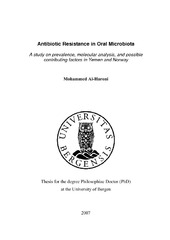| dc.description.abstract | Worldwide antibiotic resistance among oral microbiota is an increasing problem and information regarding such resistance is completely lacking for Yemen and very limited data is available for Norway. The aims of the current thesis were to (1) disclose the prevalence of ampicillin and metronidazole resistance among selected subgingival microbial species obtained from individuals in Yemen and Norway (paper 1), (2) determine the susceptibility pattern of Fusobacterium nucleatum isolated from Yemen and characterize the aminopenicillins-resistance determinant of F. nucleatum (paper 2), and (3) assess if antimicrobial prescription practices by dentists in Yemen and Norway could possibly contribute to the current prevalence and the emergence of bacterial resistance in these geographically separate locations (papers 3 and 4). Materials: Thirty-four and 21 subgingival plaque samples from Yemen and Norway, respectively, were cultivated on fastidious anaerobic blood agar containing 2 μg/mL of either ampicillin or metronidazole. The bacterial growth from each plate was then screened using DNA-DNA checkerboard hybridization technique for the presence of ampicillin and metronidazole resistance among 18 selected subgingival species (paper 1). Ampicillin-resistant F. nucleatum strains were isolated from Yemen by cultivating subgingival plaque samples on crystal violet erythromycin (CVE) plates supplemented with or without 2 μg/mL ampicillin. The molecular basis of ampicillin resistance among F. nucleatum strains was studied using two-dimensional gel electrophoresis and mass spectrometry (paper 2).The antimicrobials prescription knowledge of Yemeni dentists was investigated by distributing a structured questionnaire to all working dentists in the three major governorates in Yemen. The questionnaire aimed at investigating the therapeutic and prophylactic use of antimicrobials with relevant clinical and non-clinical parameters (paper 3). The Norwegian dentists’ antimicrobial prescription practices were revealed by analyzing aggregated data obtained from the Norwegian Prescription Database (NorPD) on the basis of their total prescriptions of 11 antibiotics issued in 2004 and 2005. Consumptions of these antibiotics in dental practice were measured using the WHO measurement unit, the Defined Daily Dose (DDD) (paper 4). Results: A statistically significant higher resistance to metronidazole and ampicillin among nine and seven species (P <0.05), respectively, was found in Yemeni isolates compared with Norwegian ones. The molecular characterization of ampicillin-resistant F. nucleatum isolates showed that ampicillin-resistant F. nucleatum isolates harboured a class D β-lactamase enzyme. In addition, increased synthesis of two proteins, enolase and ABC transporter ATP-binding proteins, was associated with β-lactamase enzyme production. A sound knowledge of antimicrobials prescription among Yemeni dentists was lacking with a trend of overuse. NorPD data showed antimicrobial prescribing trend in favour of narrow-spectrum penicillins among Norwegian dentists. Conclusions: The findings indicate that high prevalence of resistance among oral bacteria in Yemen maybe a potential threat in the management of dental infections in the region. Antimicrobial overuse by dentists in Yemen could exacerbate the existing dilemma of antimicrobial resistance of oral bacteria. In contrast, the low prevalence of resistance among subgingival species in Norway is most probably a result of the judicious use of antimicrobials, that is, more restrictive prescribing practices in the country. The presence of class D β-lactamase among ampicillin- resistant F. nucleatum strains increases their virulence and cost of treatments as these enzymes might present resistance to several classes of β-lactam antibiotics. Recommendations: Halting resistance development and saving effectiveness of antimicrobials need strict, practical, and feasible approaches. There is an urgent need to formulate an action plan to counter the revealed situation of antimicrobial resistance in Yemen. A proposed strategy to be adopted in the country for the control of antimicrobial resistance should be based on the prevention of communicable diseases and infection control to reduce the need for antimicrobial agents. An antimicrobial resistance surveillance system and a multidisciplinary committee that monitors antimicrobial use in the country should form integral parts of a structured approach to reduce antimicrobial resistance by improving antimicrobial prescribing. Finally, such an effective strategy requires close cooperation and consultation between Yemen and other involved parties, both at national and international levels. | en_US |
